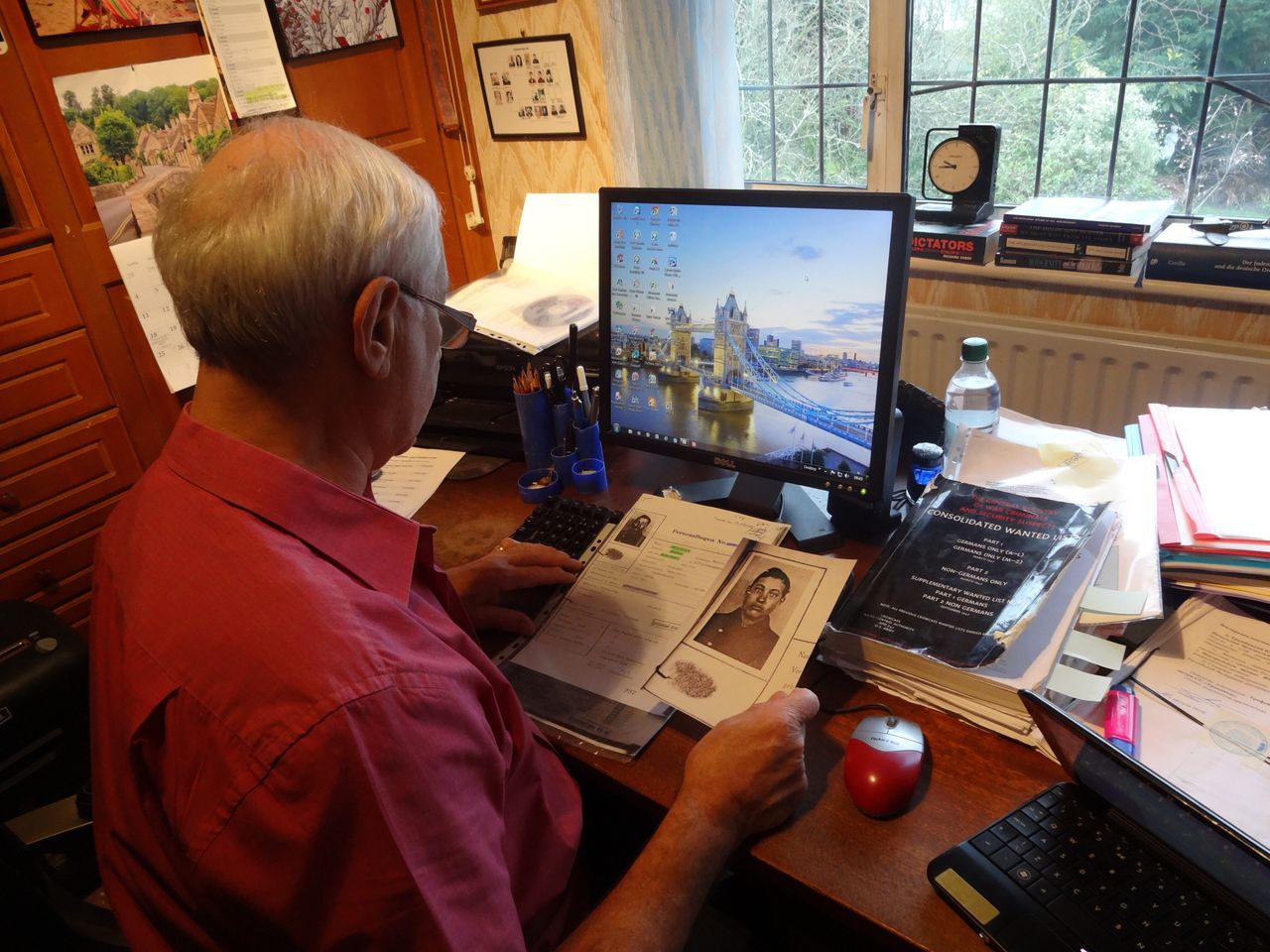
Dr Stephen Ankier doesn’t like being called a Nazi hunter and he certainly doesn’t look like Brad Pitt’s character in Quentin Tarantino’s Inglourious Basterds. Rather than a grim-faced vigilante, Ankier looks like a white-haired, mild-mannered 75-year-old scientist, which he is. The ‘Nazi-hunting’ came later on.
He is Britain’s most successful self-taught tracker of war criminals, handing over dossiers on dozens of Auschwitz guards to German authorities and the first to identify an alleged Waffen SS officer living in Minnesota, who had been a commander in a Nazi-sponsored Ukrainian unit. Ankier is also intensely private, insisting we meet at a coffee shop away from his home in Edgware, north west London, on a table tucked as far away from other customers as possible.
Ankier describes himself as a ‘Holocaust researcher’, but his subjects are not yet history. He is currently pursuing action against several alleged Nazi collaborators and war crimes perpetrators living in Britain today.
Living, but probably not for much longer.
“It’s about Lady Justice beating the Grim Reaper,” he says, when I ask how long he’ll still be in a job. “Death will take them all soon.”
“One of them which I had a lot of information on died last year in June,” he elaborates. “By July, I had a whole dossier on him showing he was a war criminal, very little doubt about that. He machine-gunned civilians and there are Russian documents to prove it.”
His most significant discovery, the former 31st Punitive Battallion officer Michael Karkoc, will be 96 in March.
Karkoc was a founding member of a Nazi-sponsored Ukrainian unit, and latterly in the Waffen SS. Detailed records have been unearthed by Ankier and later by the Associated Press showing Karkoc’s detachment was probably present at the violent suppression of the 1944 Warsaw uprising, where there was a mass killing of thousands of Polish civilians. Karkoc utterly denies his involvement in any atrocities, and has lived a comfortable life in Minneapolis for many decades.
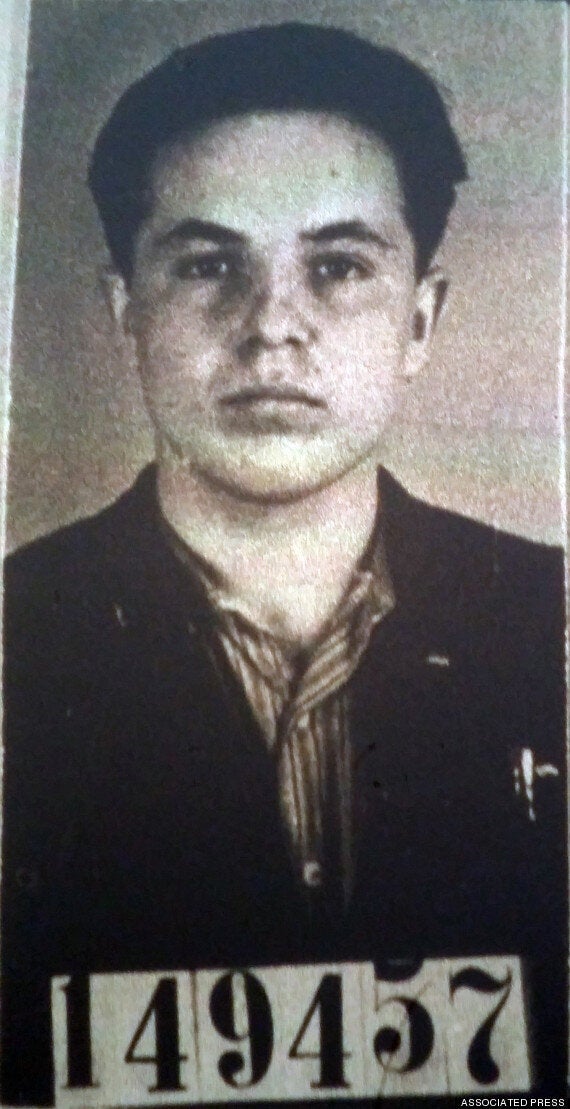
This photo of Michael Karkoc was part of his application for German citizenship filed with the Nazi SS-run immigration office in 1940
But as time marches on, and the German legal system plods, there are few left who really have their heart on pursuing Nazis when death is so near. “If they die, it solves everyone’s problem, to be honest. But I never doubt the worth of it,” Ankier insists.
“My target is documenting the truth. It’s not about counting scalps. It’s about getting the truth. I don’t like being called ‘Nazi hunter’. It sensationalises work that is still very important. I’m not into that.”
The discovery of Karkoc, publicised in 2013, was by all accounts a coincidence. Ankier’s focus had been tracing Nazis and accomplices living in the UK. He believes there are still a handful here, alive. And he knows who many of them are, though he won’t put an exact number on them. A new 89-year-old suspect, he believes, will have his name in the press within the coming weeks.
“Is the United Kingdom a haven for Nazi war criminals? Probably not, but it certainly has harboured them… I believe others are here, under the radar. The witnesses are dying, the perpetrators are not willing to talk. So it is very difficult to get enough evidence.
“But nobody else is doing it. All of the evidence is out there, but more people could take it on.”
His methods could hardly be more different than the world’s foremost living Nazi hunter, Ephraim Zuroff, the lead investigator at the Simon Wiesenthal Centre in the US and Israel, regularly a talking head on television and who publishes a ‘Most Wanted’ list every year.
Ankier says Zuroff has not shown any interest in him, though he had a very cordial relationship with Wiesenthal himself before his death. Zuroff’s modus operandi is starkly different, Ankier says. “He has his own reasons for whatever he chooses to do. That’s not my objective. He doesn’t particularly want to co-operate, and he is doing a good job in many respects, so…” he trails off.

Correspondence with the Simon Wiesenthal Centre from Dr Ankier
Though Ankier plays down his own talent, and is so concerned about privacy that he refuses to be photographed, he does have a very specific set of skills and personal attachment that make him a natural Nazi investigator. He was an eminent pharmacologist, used to looking for clues among vast data to make unexpected connections; he later trained in medical law.
He has a talent for finding solutions, he uses software to transliterate complex Cyrillic documents through a scanner, and then translating them using Google. He often compares and contrasts his research now with his life in science, describing the moment he first identified Alexander Huryn in 2008, who is believed to be a former Nazi prison guard from the Trawniki concentration camp now 94 years old and believed to be still living in Fareham, near Southampton.
“You look and stare and you can’t believe it, you look from one side to another and compare everything,” he says, his serious face suddenly a-glow.
“There is a moment of excitement. And it was the same feeling I had as a scientist, doing research. You think to yourself, ‘I know something nobody else in the world knows’. That is a very strange feeling. I felt an immediate urge to tell someone at once. I can’t keep this a secret, because if I drop dead this minute, it’ll be a secret again. I told my MP, and wrote a report for the police at Scotland Yard with all the other names from Trawniki I knew. Very soon after that I was invited to make a presentation to senior Metropolitan police officers at New Scotland Yard.”
There are deeply personal motivations for Ankier to do this work. He was born in north west London, but is the child of Jewish Polish parents who found refuge in the UK in 1936 and who, he says, raised their son to be as British as he could be. During the war, his family moved to Minehead in Somerset, where he once terrified his family by wading out to sea towards a minefield.
“Everyone was in such a panic, in a really bad state. It taught me a lesson about curiosity. Be curious, but be cautious.”
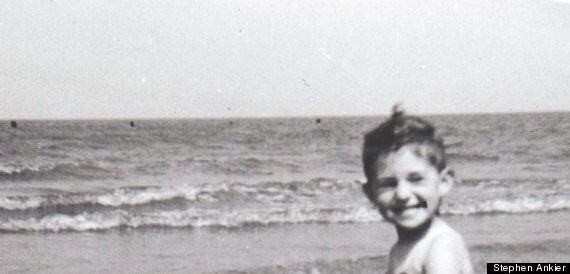
Ankier as a child on the beach in Minehead, with the black dots of a minefield behind him
His family spent the end of the war back in north London, where as a child he remembers the bombs dropping close to his home in Golders Green and his neighbour’s roof blown off. But after the war “no one talked about the Holocaust, my parents had no idea who was alive or dead”. At his barmitzvah, eight years after the war, the family were visited by some very distant Belgian relatives, who Ankier believes were hidden as children. He recalls them talking in hushed tones about ‘Auschwitz’, and wondering what the word could mean. “When you’re a teenager your mind is on lots of other things,” he says with a small smile. “Family history usually becomes interesting when it’s almost too late.”
But he was gaining an interest in history, if not professionally. As a pharmacy student in 1961, he travelled to Israel for Adolf Eichmann’s trial, and sat awestruck at the “theatre” of the courtroom, as one of the architects of the Holocaust sat placid in front of him.
“I looked at him with my own eyes, in the flesh. There were hundreds there. The unnerving part was that the people sitting with me were all survivors. And they were not sitting quietly, as if it were a real theatre, the people next to me were sobbing, groaning, making noises. It was bizarre, something I had never experienced before. I had a simultaneous translation headset, from Hebrew into English, and others were taking it, saying ‘let me listen’. Then they heard something mentioned that they knew about and got into a terrible state, some were hysterical.
“I was rattled when I left there; it was like having been on a strange planet. It left me stunned. Is this real, can it be real?”
Like many amateur historians, Ankier first delved into the past to try to uncover his own family history. He was watching a Granada TV programme in 1983, long before the Steven Spielberg movie, called Schindler’s Ark, about the famous Nazi party member Oskar Schindler who saved 1,200 Jews from concentration camps across Poland and Germany.
As the pictures of the names flashed up on screen, his hackles were suddenly raised to attention. It was his own surname, the letters in black in the uniform script. “It stunned me. Hairs stood up on the back of my neck. I thought that has to be a relative. Such an unusual name.”
In 1993, he found the name on the list again, when the Spielberg film was released. It was no mistake, there was 'Chaskiel Ankier'. And he was alive, Ankier discovered, living in Israel but too traumatised to meet or talk. Ankier attempted a meeting in Jerusalem but to no avail. “His daughter told me that he breaks down a lot and cries inconsolably thinking about when he was a prisoner of the Nazis,” Ankier says. “We corresponded, but that was the end of it.”
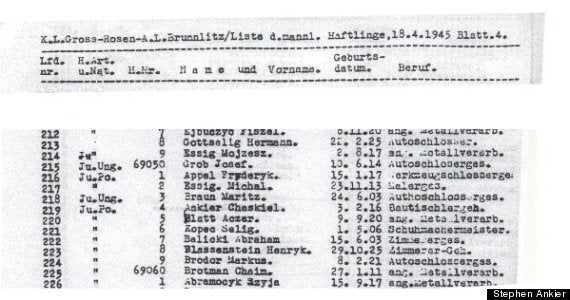
The original Schindler's list - with the name 'Ankier' on it
During the 1990s, with no easy access to documents, Ankier began to hit brick walls searching for his family. “The internet is a wonderful thing, but it didn’t exist when I started out and I had to write letters to many, many overseas town halls to get information. And they wanted money for the documents, which needed to be found in the archives, which I didn’t have. I didn’t speak the language. I didn’t get far, to say the least.”
There was no light bulb moment, Ankier said, but he began slowly to think about the perpetrators more than the victims. “These victims didn’t die in a vacuum. Someone actually killed them. Who are they? They’re people too, just like anyone else.”
One particular fact piqued his interest though, a TV documentary about suspected ex-SS officers living in Britain after having been in an Allied prisoner of war camp in Rimini, Italy.
As many as 8,000 of these men, members of that infamous Nazi-sponsored Ukrainian SS-Galizien, are thought to have ended up in Britain. “Their names were on the 'Rimini list', classified by the British government,” Ankier explains. “Effectively that meant that no one was allowed to trace them or do anything about them, despite the suspicion that there were war criminals among that group, who were living in Britain.”
Starting off as a layman feeling his way, it was tough in the beginning to get access to any official documents, but here Ankier was lucky again. His MP, Andrew Dismore, who took a great interest in tracking down suspected Nazis in Britain, Dismore sent many letters of official introduction, asked for help from archivists, and shared information he had access to.
But Labour’s Dismore lost his seat to his Conservative opponent in 2010, and Ankier found his new MP Matthew Offord far less interested in helping his work, intimating that he had been an active obstruction despite initial, sparse pleasantries.
“But I guess that I must have built my own name up, people began to know me by reputation and results,” Ankier adds.
He began to make detailed enquiries, and study more detailed lists of former commanders and guards from Poland, Ukraine, Germany and the UK. As his enquiries become more public, he began to receive anonymous tip-offs. “A name is not good enough, you need a date of birth and a place of birth, and that can still be a coincidence.” One of the tip-offs he received was “a brown paper envelope through the door” listing the names of Trawniki guards, led him to Huryn, and gave a him a great deal more leads. “That’s all I can say about how I got it, but it’s quite genuine and this sort of thing does happen from time to time. Ankier believes there is still chance of a case against Huryn.
“He could be prosecuted for lying on his entry documents, if that is what happened and stripped of British citizenship, if it’s proved,” he says. “Did he lie on his application about his wartime activities? And if he did then there would be ground to have his citizenship removed [technically called Deprivation]. I made representations, sent in a Freedom of Information request and Offord announced publicly that he would investigate - but there never was any further feedback on the subject, possibly because of privacy law. But why should such a law protect anyone if they had allegedly breached other laws?
“He [Huryn] says he had no alternative, it was join up or be shot. That might have been true. But at the end of the day, we are each accountable for our actions and many [Ukrainians] deserted rather than be part of that group.”
Huryn has claimed he only took the job under duressIn 2011, he told the Mirror: “My family got a letter from the Nazis asking people to sign up. We had to go or they would have confiscated our farm and put my whole family in a concentration camp. I was sent because I was the eldest child. I had no choice. The Nazis took me away on a truck. I was very scared, I had no idea where I was going and definitely did not want to be there.”
As far as war crimes go, the Crown Prosecution Service has exceptionally strict guidelines. With Huryn, there are several strong legal obstacles. “They know he was a guard at Trawniki [the notorious concentration camp where Nazi officers trained Ukrainians in brutality and 6,000 Jews were held, many murdered], but that’s not enough. You have to attach him, as an individual, to an atrocity before any legal proceedings might even be considered. Most of the witnesses are dead and any other guards who might be found are hardly likely to talk, so how do you do that?
“I argued with the police. I said, ‘look, there’s a prison camp, inside people are being murdered’, which is incontrovertible. And he admits being a guard, standing on the outside of the barbed wire, with a loaded weapon making sure no one gets away.
“Does that make him part of the murderous system? To my mind, obviously it does. But according to the police, he didn’t pull the trigger, so they can’t do anything.”
Ankier mulled going down to see Huryn himself “many, many times”.
“It would have been very provocative,’ he admits. “I didn’t. I held back.”
“It’s understandable that the police are not that interested when the evidence is circumstantial,” he continues, refusing to be drawn into any criticism. “There’s a major terror threat, budgets have been slashed and they have, in their minds and in my mind too, more important things to do. If I came up with a red hot case of someone who had directly committed an atrocity, it might be different. But the CPS rules are very stringent. You have to come up to the guidelines or forget it.”
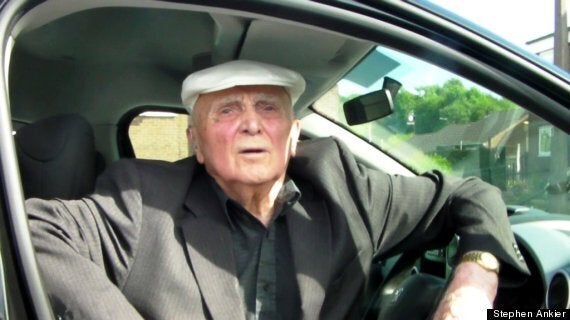
Mychajlo Ostapenko, confronted by Ankier in his car close to his home in Lancashire
When the police cannot help, Ankier says his only option is to “name and shame” through the press. “What sanctions are left, if they have hidden everything? My main mission is assembling the facts. It is for others to take matters further.”
It was through the media that Ankier did indeed confront one of his alleged suspects, one Mychajlo Ostapenko, an 89-year-old from Nelson, Lancashire, alleged to have been in the same Nazi-sponsored unit as Karkoc. “I wanted to confront the devil, in my own suspicions. I wanted to look evil straight in the eye, or what I imagined it to be.”
He travelled to the home of his subject with a reporter, marveling at the beautiful scenery. “It was so weird, in such a beautiful part of the world, there was this very old man, in a cloth cap. He drove himself up to us. When we talked, he remembered everything, it seemed, apart from the critical time when strong circumstantial evidence shows that he was in this unit of the Ukrainian Self-Defence Legion, when they committed all the atrocities.
“He obfuscated, he would say he couldn’t remember anything. I said, ‘is it because you can’t remember or you don’t want to remember?’ and he just continued with remarks like ‘I can’t remember, I have no idea.’ He says he can’t remember what army he belongs to. He doesn’t know if he shot anyone, but he did have a gun. He says he spent nine months in hospital with appendicitis - what an extraordinary medical condition!”
Ostapenko told the Mail On Sunday at the time: "I was in an army but I never fought anyone. I haven’t done anything wrong. I haven’t killed anybody. I was in the Rimini camp. The British looked after us well. I can’t remember anything else. I’m sorry."
The visit, Ankier admits, “might have been a mistake, I don’t want to act like law enforcement”. So far, no direct evidence has come to light to pin any war crimes on Ostapenko, only documents which put him in the unit at the time they committed atrocities. “But that doesn’t cut it,” Ankier shrugs.
Several alleged Nazi war criminals have already slipped into the grave before they could be put in a court room. One of his key targets, which Ankier is convinced “would have appeared in court if he had lived” was Mychailo Fostun, also a member of that Ukrainian Nazi detachment. SS lists show Fostun was present at the massacre of thousands of Jews in the ghetto of the Polish town of Bialystock in August 1943, as well as having been a guard at Trawniki.
Fostun lived in Wimbledon, south-west London, until his death, and never denied being a guard or a member of the battalions, but did deny he committed atrocities. Newspapers printed all of Ankier’s research when the details were collated in 2003.
“Then he died mysteriously in the Ukraine, in a car crash, in 2004,” Ankier said. “The press were hounding him, his case had been brought up in the House of Commons, the UK police had taken an interest in his background, and I’m sure he knew an awful lot about who had done what in the unit. But I was assured the car crash was genuine but it seemed very convenient.” He raises his eyebrows. Fostun’s name was on that same list in the “brown envelope” naming the guards.
As his work gained more press attention, Ankier found himself being asked for advice from international prosecutors, who also provided him with crucial extra information – including the list of Rimini prisoners of war that he had tried so long to obtain from the British government.
“In late 2010, the Germans had a red-hot suspect for the Lviv massacre of Jews and the investigating prosecutor had got in touch and asked if I could help. And she offered to send me the Rimini list, and asked me to check them off against who I knew. Wow!”
It arrived, 450 pages long, and Ankier set about trying to connect names of Ukrainians on that list with his separate lists of Trawniki concentration camp guards and of the Ukrainian Self defence Legion.
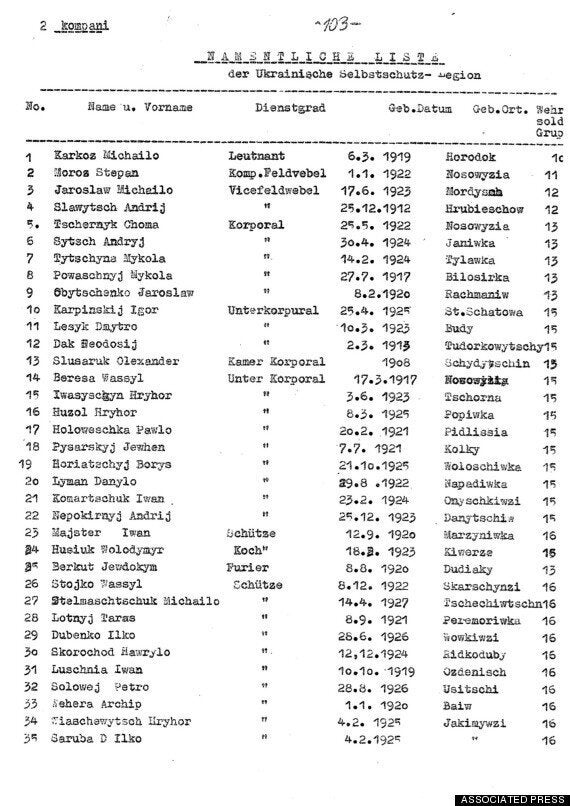
An SS administrative file probably dated 1944 and now located in the Polish National Archive in Krakow, which shows a roster list for the Nazi-collaborating Ukrainian Self Defence Legion, identifying Michail Karkoc as the top commander of the company
It was that list that led him, indirectly, to Karkoc, and it was Ankier’s information that directly led to the German Federal Court of Justice’s decision in May 2014 that there was enough evidence to prosecute. Now there is another wait, for an arrest warrant to be issued by the state prosecutor in Bavaria. Then the Americans may receive a request for extradition.
World events too, sometimes get in the way, and turmoil in Ukraine has meant some crucial files are now in lockdown in Kiev. It is a long road ahead. “I must stress that Mr Karkoc is, as of now, legally an innocent man, innocent until proven guilty,” Ankier says, carefully.
Speaking after the German court's ruling his father could be prosecuted, Andrij Karkoc told The Minneapolis Star Tribune: "He’s crushed by it. These slanders will probably stand and my father will die, carrying them to his grave. He cannot, for the life of him, understand how in America, a loyal citizen and innocent man can be so hideously lied about.”
Ankier is somewhat optimistic Karkoc will see the inside of a courtroom, though he chooses his words carefully. But his reason for optimism is double-edged. “The only ones where there is a serious chance of prosecuting them are people with a senior command position. If a unit committed a crime, the commander is held responsible. But those commanders are even older, the [those] alive now were youngsters then and less likely to have been in command, so that responsibility cannot be attributed to them. Karkoc was a commander.”
It is now no longer this specific Nazi detachment in Ukraine that Ankier is pursuing. “I have also been looking for Auschwitz guards, and I’ve reported at least 20 to the German authorities with names, dates of birth and a short history of their wartime activities. I also found a few Majdanek [another Polish concentration and extermination camp] guards and one or two Einsatzgruppe [paramilitary death squads of Nazi Germany that were responsible for mass killings] who may be alive - they have been reported to the German authorities.
“The Germans are taking their investigations very seriously but I have no idea if these men are compos mentis or even very unlikely but just possibly 'namesakes'. Of course they may have died recently!
“The names have not been published, but journalists in Germany are aware of who they are. It is all resting with the authorities now.”
It is a pursuit with an expiry date that Ankier knows all too well. One day, he will be ‘out of business’. Then he will get a new part-time pursuit. “I still want to finish writing our family history. I want to keep up my work on medical law and research. And I love music. I used to play the piano, though not that well, really. So when all the Nazis are dead, I can concentrate on learning the piano again, in between doing the gardening and playing with the grandchildren, doing some boating and travelling to new and exotic places. There’s a lot to do.”
He smiles. “I haven’t decided what I want to do when I grow up, never mind retire. I’ll never retire.”
